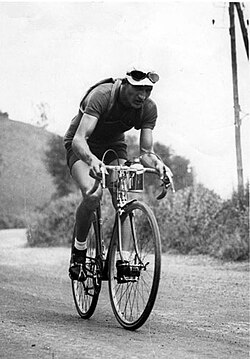Rescues and Resistance role during World War II
[edit]
Bartali earned respect for his work in helping Jews who were being persecuted by the Nazis during the time of the Italian Social Republic. He appears as a character in the 1978 novel, The Assisi Underground: The Priest who Rescued Jews, and in the 1985 American television film adaptation, both based on the real-life account by Father Rufino Niccacci.
It emerged in December 2010 that Bartali had hidden a Jewish family in his cellar and, according to one of the survivors, saved their lives in doing so.[17]
Bartali used his fame to carry messages and documents to the Italian Resistance.[18][19] Bartali cycled from Florence through Tuscany, Umbria, and Marche, many times traveling as far afield as Assisi, all the while wearing the racing jersey emblazoned with his name. Neither the Fascist police nor the German troops risked discontent by arresting him.
Giorgio Nissim, a Jewish accountant from Pisa,[18] was a member of DELASEM,[20] founded by the Union of the Israelitic Communities to help Jewish Italians escape persecution. The network in Tuscany was discovered in autumn 1943 and all Jewish members except Nissim sent to concentration camps. With the help of the Archbishops of Genoa Pietro Boetto and Florence Elia Dalla Costa, the Franciscan Friars of Assisi and others, Nissim reorganized DELASEM in Tuscany and helped 800 survive.
Nissim died in 2000. His sons found from his diaries that Bartali had used his fame to help. Nissim and the Oblati Friars of Lucca forged documents and needed photographs of those they were helping. Bartali used to leave Florence in the morning, pretending to train, ride to Assisi where many Jews were hiding in the Franciscan convents, collect their photographs and ride back to Nissim.[5][21][22] At Assisi Bartali was in direct contact with Rufino Niccacci.[23] Bartali also used his position to learn about raids on safehouses.
Bartali was eventually taken to Villa Triste in Florence. The SD and the Italian RSS official Mario Carità questioned Bartali, threatening his life.[22] In spite of any threats, Bartali did not reveal what he had done. Even after the war he never boasted his merits; he used to say: "Some medals are made to hang on the soul, not the jacket."[24]
Bartali continued working with the Assisi Network. In 1943, he led Jewish refugees towards the Swiss Alps himself. He cycled, pulling a wagon with a secret compartment, telling patrols it was just part of his training. Bartali told his son Andrea only that "One does these things and then that's that".[22]
In June 2012, a book about Bartali's wartime activities, Road To Valor by Aili and Andres McConnon, was published.[25]
In 2013, Yad Vashem awarded Gino Bartali the honour Righteous Among the Nations.[26] He is a central figure in the 2014 documentary My Italian Secret: The Forgotten Heroes.[5] In 2007, the script for a movie based on Bartali during World War II, called Lion Man of Tuscany was on the Black List, a survey of the "most liked" un-produced scripts in Hollywood.[27]
In 2017, research by Michele Sarfatti questioned Bartali's efforts to save Jewish lives, referring to the very limited sources and contradicting that Bartali would have described this in his diaries.[28] In 2021, Marco and Stefano Pivato corroborated this stance by Sarfatti, calling the whole story 'invented' ('una storia inventata').[29][30] In 2021, an interview with Sergio Della Pergola, an Israeli-Italian academic who was involved in Yad Vashem’s investigation of Bartali’s role during the war, was published in the Corriere della Sera. Outlining some of the evidence regarding Bartali’s efforts during the war, he disagreed with the argument put forth by Sarfatti and Marco and Stefano Pivato. He was quoted as saying: “To question whether Gino Bartali risked his life to save Jews is like denying that the Earth is round.”[31]
 |
| Courtesy of Breitling For Gino Bartali |



No comments:
Post a Comment